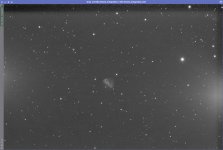cloudbait
Well-known member
Maybe. The 10 samples you provided all have the amp glow on the right. Might be interesting to run WBPP twice, separating the lights across your flip.Wouldn't it show up on both sides depending on how much I captured on each side of the meridian flip? In this case, most of my lights subs were on one side due to most of my lights being captured after the meridian flip. Also, if it is a star out of frame, wouldn't it show up in my Ha and OIII as well?


